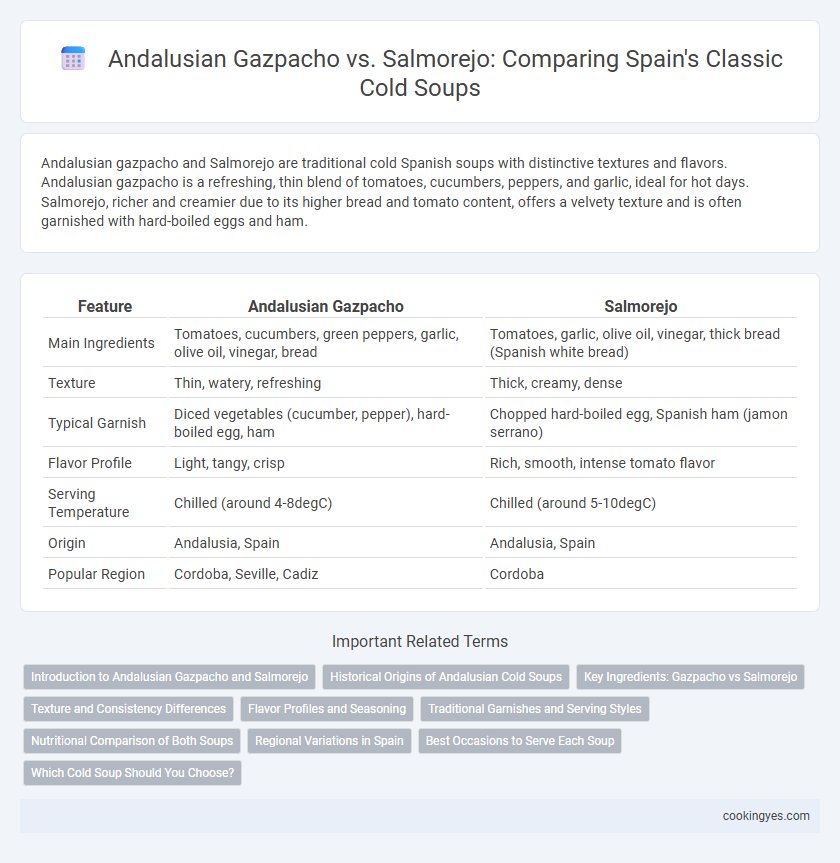Andalusian gazpacho and Salmorejo are traditional cold Spanish soups with distinctive textures and flavors. Andalusian gazpacho is a refreshing, thin blend of tomatoes, cucumbers, peppers, and garlic, ideal for hot days. Salmorejo, richer and creamier due to its higher bread and tomato content, offers a velvety texture and is often garnished with hard-boiled eggs and ham.
Table of Comparison
| Feature | Andalusian Gazpacho | Salmorejo |
|---|---|---|
| Main Ingredients | Tomatoes, cucumbers, green peppers, garlic, olive oil, vinegar, bread | Tomatoes, garlic, olive oil, vinegar, thick bread (Spanish white bread) |
| Texture | Thin, watery, refreshing | Thick, creamy, dense |
| Typical Garnish | Diced vegetables (cucumber, pepper), hard-boiled egg, ham | Chopped hard-boiled egg, Spanish ham (jamon serrano) |
| Flavor Profile | Light, tangy, crisp | Rich, smooth, intense tomato flavor |
| Serving Temperature | Chilled (around 4-8degC) | Chilled (around 5-10degC) |
| Origin | Andalusia, Spain | Andalusia, Spain |
| Popular Region | Cordoba, Seville, Cadiz | Cordoba |
Introduction to Andalusian Gazpacho and Salmorejo
Andalusian gazpacho is a refreshing cold soup made from blended tomatoes, cucumbers, bell peppers, garlic, olive oil, vinegar, and stale bread, offering a light and tangy flavor perfect for hot climates. Salmorejo, originating from Cordoba, features a thicker texture relying heavily on ripe tomatoes, olive oil, garlic, and a larger proportion of bread, creating a creamier and richer taste. Both soups reflect Andalusian culinary tradition, with gazpacho emphasizing freshness and salmorejo delivering a hearty, velvety consistency.
Historical Origins of Andalusian Cold Soups
Andalusian gazpacho and salmorejo both trace their origins to the southern region of Spain, particularly Andalusia, where the hot climate inspired the creation of refreshing cold soups. Gazpacho, dating back to Roman times, evolved from bread, garlic, vinegar, olive oil, and raw vegetables to become a vibrant tomato-based soup after the introduction of tomatoes from the Americas in the 16th century. Salmorejo, on the other hand, developed later as a thicker, creamier variant emphasizing the use of stale bread, tomatoes, and olive oil, reflecting Andalusia's agricultural abundance and culinary traditions.
Key Ingredients: Gazpacho vs Salmorejo
Gazpacho features key ingredients like ripe tomatoes, cucumbers, green bell peppers, garlic, olive oil, vinegar, and stale bread, creating a thin, refreshing cold soup. Salmorejo's base relies heavily on tomatoes and a greater amount of soaked bread, with a richer texture enhanced by olive oil and garlic but typically lacks cucumbers and peppers. These ingredient differences define Gazpacho's light, tangy profile contrasted with Salmorejo's creamy, dense consistency in traditional Andalusian cold soups.
Texture and Consistency Differences
Andalusian gazpacho features a thin, watery texture with a refreshing consistency, emphasizing a light, drinkable quality ideal for hot weather. Salmorejo presents a thicker, creamier consistency owing to its higher bread and olive oil content, offering a rich, velvety mouthfeel. These textural differences highlight Andalusian gazpacho's refreshing clarity versus salmorejo's hearty, smooth density.
Flavor Profiles and Seasoning
Andalusian gazpacho features a vibrant, tangy flavor profile with fresh ingredients like tomatoes, cucumbers, green peppers, garlic, and vinegar, creating a refreshing and slightly acidic taste. Salmorejo offers a richer, creamier texture due to its higher bread and olive oil content, resulting in a mellow, smooth flavor dominated by ripe tomatoes and subtle garlic notes. Seasoning in gazpacho emphasizes brightness with vinegar and fresh herbs, while salmorejo relies on olive oil and cured ham toppings to enhance its savory depth.
Traditional Garnishes and Serving Styles
Andalusian gazpacho traditionally features finely chopped cucumber, green pepper, and croutons as garnishes, served chilled in a bowl or glass, emphasizing its light, refreshing texture. In contrast, Salmorejo is thicker and creamier, typically topped with diced hard-boiled eggs and serrano ham, reflecting its richer, more robust serving style. Both soups showcase the vibrant flavors of Spanish cuisine but differ significantly in presentation and texture.
Nutritional Comparison of Both Soups
Andalusian gazpacho is a low-calorie, hydrating cold soup rich in vitamins A, C, and antioxidants from fresh tomatoes, cucumbers, and bell peppers, providing a light, refreshing option with high fiber content. Salmorejo contains higher calories and fat due to its olive oil and bread base, offering more energy and a creamier texture while supplying a good amount of vitamin E and healthy monounsaturated fats. Both soups support heart health and hydration, but the choice depends on dietary preference for lower calories in gazpacho or more sustained energy from salmorejo.
Regional Variations in Spain
Andalusian gazpacho, originating from southern Spain, features a thin, refreshing blend of tomatoes, cucumbers, peppers, garlic, olive oil, and vinegar, served cold as a summer staple. Salmorejo, a thicker and creamier cold soup from Cordoba in Andalusia, relies heavily on tomatoes and bread with a richer olive oil content, often garnished with hard-boiled eggs and Iberian ham. These regional variations highlight Spain's diverse ingredients and preferences in cold soups, reflecting Andalusia's culinary heritage with differences in texture, consistency, and serving style.
Best Occasions to Serve Each Soup
Andalusian gazpacho is ideal for hot summer days and outdoor gatherings due to its refreshing, light texture and vibrant blend of tomatoes, cucumbers, and peppers. Salmorejo, richer and creamier with a thick consistency from bread and olive oil, pairs perfectly with tapas nights or as a hearty appetizer during cooler evenings. Both cold Spanish soups showcase Andalusian culinary traditions but serve distinct purposes based on seasonality and meal style.
Which Cold Soup Should You Choose?
Andalusian gazpacho is a light, refreshing cold soup made from blended tomatoes, cucumbers, bell peppers, garlic, olive oil, vinegar, and stale bread, offering a thin, drinkable texture ideal for hot summer days. Salmorejo, originating from Cordoba, is a thicker, creamier version primarily composed of tomatoes, bread, garlic, and olive oil, often garnished with hard-boiled eggs and cured ham, providing a richer and more filling option. Choose gazpacho for a hydrating, low-calorie snack and salmorejo when seeking a hearty, smooth dish with a deeper tomato flavor.
Andalusian gazpacho vs Salmorejo for cold Spanish soups Infographic

 cookingyes.com
cookingyes.com